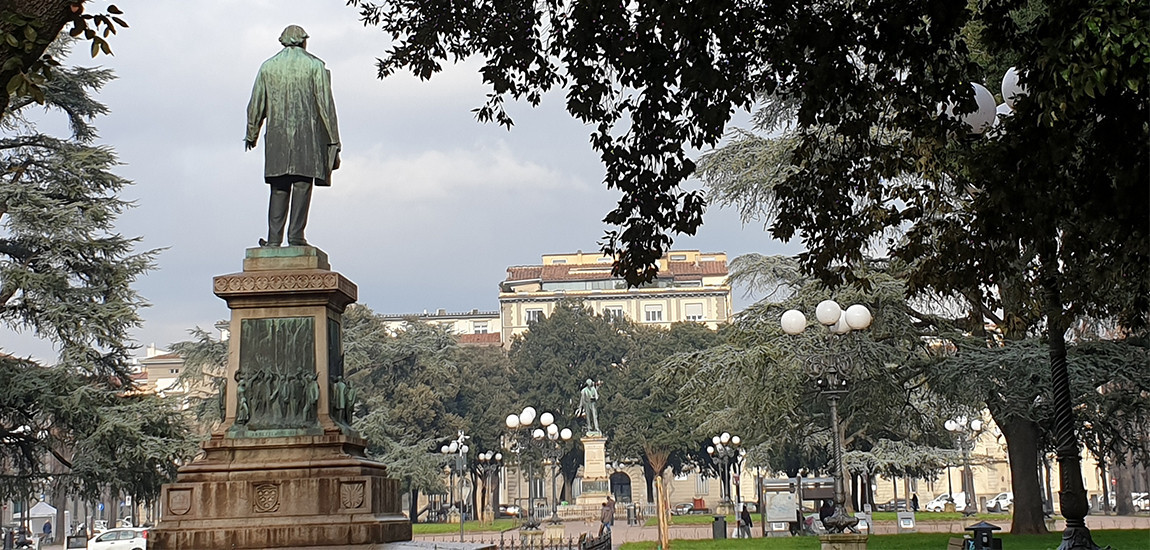
Piazza Indipendenza and its stories
A large square near the Santa Maria Novella
station and the boulevards. The rich vegetation, composed of linden and holm
oaks, has recently been enriched by cherry trees and 500 white iceberg roses in
the flower beds.
It was part of a huge area of vegetable gardens and meadows
that until the second half of the 1800s extended along the second circle of the
walls, called Arnolfo’s Walls (because it was designed in 1282 by Arnolfo di
Cambio) and in front of the great Fortezza da Basso, built
between 1534 and 1537. It was called piazza "di Barbano", from the name of
the Marquis Barbolani da Montauto who owned most of the land.
In 1838 Leopold
II of Habsburg-Lorraine, then reigning, decided to urbanize the area and to use
it for the construction of 53 houses for 318 poor families. The families at the
time were very numerous, so it involved thousands of people. The urbanization was carried out in
1844-45, including the area of the square that was baptized Piazza Maria
Antonia (the name of the Grand Duke's wife), although it remained a terrain of clay and gravel, closed by railings. The land, divided into lots, was bought
entirely by merchants, rich bourgeois and aristocrats, and houses for the poor
were no longer talked about. An example of political corruption that will not
be the last.
In the square, on 27 April 1859, began a peaceful demonstration
which led to the fall of the Grand Duke Leopold II of Habsburg-Lorraine
and then determined the annexation of Tuscany to the future Kingdom of Italy.
About 15,000 people, gathered by the various democratic and moderate forces who
demanded that Tuscany ally with Piedmont and France in the imminent war against
Austria, marched through the city from here to Piazza Signoria. The Habsburg Lorraine
family, Austrian and linked to Vienna by treaties, could not accept. The Grand
Duke realized that the ruling class, including the majority of the aristocracy
and the army officers sided with the Piedmontese and preferred to leave that
same evening.
There was certainly a nationalistic and anti-Austrian fervor
widespread in the Italian bourgeoisie, but many things have been said about this
strange "peaceful revolution". That the officers had been corrupted
by the Piedmontese and that their agents had infiltrated months before to organize
the demonstration, that the "moderates" (bourgeoisie and aristocracy) feared
being overruled by the "democrats" who made very radical requests and
therefore had long since agreed for a "fast and quiet" transfer of
powers. In fact, they had been negotiating for months with the National
Society, a Piedmontese organization that dealt with propaganda and contacts to
support the unification of Italy managed by Piedmont and King Vittorio Emanuele
II and prevent it from happening thanks to the "democrats", led in
Florence by an exalted baker, the famous Giuseppe Dolfi. Luck was on their side though, because shortly after, the Austrians were defeated by the French and
Piedmontese in the bloody battle of Solferino, on 24 June 1859.
On the square there are also two bronze statues facing each other, which represent two of the most important
"revolutionary" aristocrats of 1859: Ubaldino Peruzzi and Bettino
Ricasoli, old acquaintances and even relatives. It is not known if they were on good terms, but now they are forced to look each other in the eye for eternity.
Even in the 60s and 70s, at the time of the great trade union and student demonstrations, the area was used as a meeting point for more numerous, violent and revolutionary marches than that of 27 April 1859. Certainly a square devoted to indipendence!



